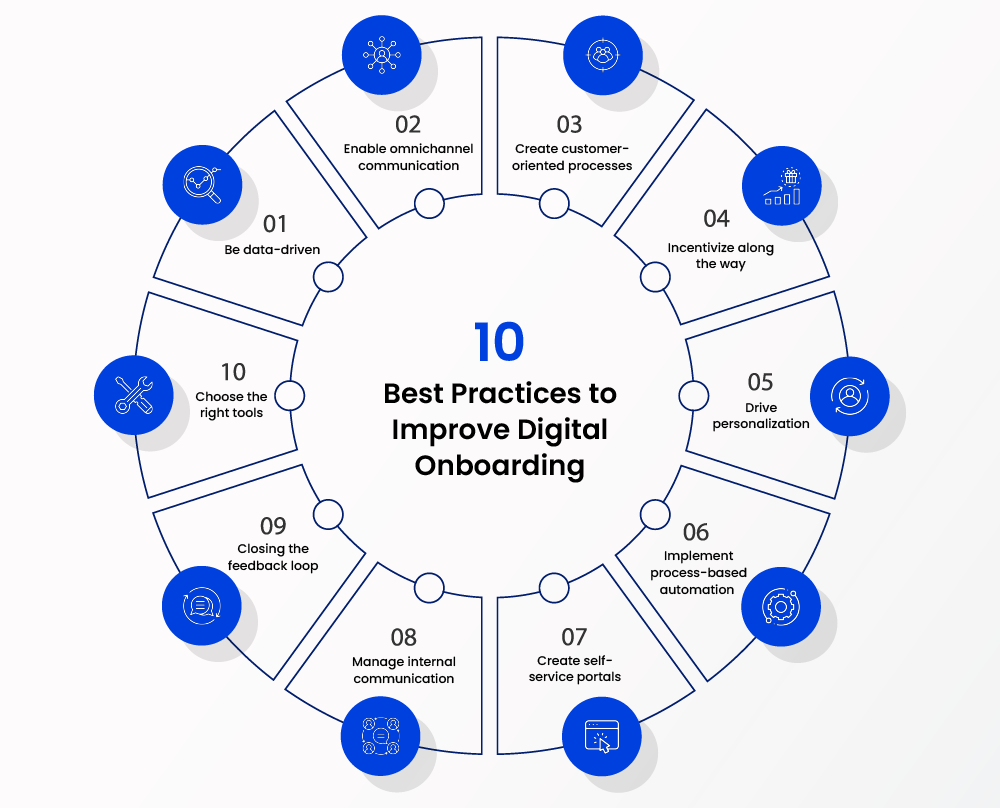Yesterday, I received a message to avail a pre-approved loan from my bank. It reminded me that, at any given point of time, I’m just a click away from instant access to credit. That’s how beautifully the retail banking sector has progressed.
Whereas, the corporate banking space still has the potential to hit this mark! On average, companies undergo an onboarding time of more than 30-days to gain access to loans, open accounts, or even use any of the bank’s products and services. With digital customer onboarding practices in place, this timeline can be reduced drastically.
Customer onboarding is the first make or break experience for any new banking customer. And the smoother the onboarding is, the more valuable a bank becomes for the customer for their everyday and long-term financial goals.
In this article, discover what digital onboarding is in the corporate banking world, its stages, best practices, and much more.
What is Digital Onboarding in Corporate Banking?
Digital onboarding in corporate banking is a process for new customers to sign up for a bank’s products and solutions. Typically, this involves planning digital application processes, e-KYC checks, document management, and a bunch of other front-end and back-end operations along the initial stages of the customer journey.
An offline approach to customer onboarding in corporate banks usually involves receiving a query from the said customer, followed by a meeting at the branch for a lengthy verification process, more paperwork, and longer turnaround times.
Sure, the trust factor was high considering that everything was in-person, but newer banking solutions are built to ensure even better security and compliance to safeguard the interests of its retail and corporate customers.
Customer onboarding isn’t limited to collecting important data from customers, it also ensures that the bank doesn’t onboard companies with fraudulent intentions. As technology progresses, a stellar digital customer onboarding experience truly has the capacity to be a competitive differentiator. Let’s compare the traditional and digital approach to customer onboarding in the next section.
Traditional Vs Digital Onboarding in Corporate Banking
Here are a few factors that determine how different stages of the customer onboarding process are carried out in a traditional and digital format:
Process | Traditional Onboarding | Digital Onboarding |
Accessibility | Branch-oriented processes for access to services | Online access to a bank’s services from anywhere |
Documentation | Manual documentation with a higher margin of error | Digital paperless documentation with better accuracy |
Verification | KYC: In-person verification | e-KYC: Biometric evaluation and OTPs |
Data Collection | Requires data to be physically filled out | Data can be picked up to autofill forms with OCR technology |
Data Management | The customer may have to share the same information, multiple times, till onboarding is complete | Customer information is centralized with digitally secure and compliant documentation |
Service TAT | Delayed access to any service can take up to 30 days. | Customers have on-demand access to banking services |
In the next section, explore the different stages of digital onboarding that are generally observed in corporate banks.
Stages of Digital Onboarding in Corporate Banks
Simply put, digital onboarding in corporate banks makes use of technology to streamline and automate a variety of functions. This can include online application forms, self-serve portals, e-signatures, etc. Besides the benefits that digital onboarding yields for customers, it’s also equally beneficial for the banks because it significantly reduces operational costs, improves process efficiency, and mitigates any type of risk.
Let’s take a more comprehensive look of the onboarding stages that are involved in the context of corporate banking:
1. Lead capture and distribution
Once an interested prospect gets in touch with a bank, their details are captured through a form submission. Then the lead is further distributed to the right teams to take the customer journey ahead.
2. Prequalification
This is when the bank sieves through potential corporate customers by checking their financial statements, credit history, and any other such line items to approve of their credibility.
3. Application and e-KYC
Once a preliminary qualification check is done, the bank vets details like the company’s registration, e-KYC verification of the identified stakeholders who will sign off transactions, etc.
4. Needs assessment
The customer-facing teams understand the customer’s needs and suggest the bank’s products and services that are the right fit for them. Banks also offer custom-packed solutions based on the company’s financial requirements, company size, business value, etc.
5. Risk assessment and approval
While preliminary qualification is done, the credit committee of the bank does a more detailed check of the company’s financial statements, outstanding loans, and other assets to qualify them for further funding.
6. Customer education
Once the banking services are made available to the customer, they are also given a walkthrough of the same. For instance, another brief on credit limits, terms and conditions of a loan, and an introduction to a dedicated relationship manager for the company for further queries.
7. Onboarding review
Customer feedback is extremely valuable for any service provider. Digitally-forward financial institutions often also have an omnichannel approach to collect customer feedback on their onboarding experience.
The stages of digital onboarding can vary based on how a corporate bank’s teams are structured, the technology solutions they use, and their internal resources. However, the above factors serve as a general foundation to what a digital onboarding experience encompasses in corporate banks.
Setbacks During Digital Onboarding in Corporate Banks
According to a study by McKinsey, about 40% of large banks face a deficit in productivity as compared to digitally-native banks. With most of these large banks having a solid foundation of legacy systems, processes can be rigid. Which is why, phasing out from such systems can be a very prominent challenge in transitioning to a digital onboarding strategy.
Here are a few common obstacles that corporate banks face while digitizing the onboarding process:
1. Data silos
Legacy systems cause fragmented data across the customer journey. During onboarding, different personnel interact with the customers such as the Branch Officer, Relationship Manager, Customer Success Executive, etc. However, data silos can cause them to not be on the same page about the customer profile. Moreover, with data across systems, it becomes difficult and risky to edit data at any stage.
2. Lack of transparency
Without a unifying solution like a banking CRM, or an application management system, a bank’s employee can find it hard to navigate where a customer stands in their onboarding process and what their next plan of action should be.
3. Implementation
Implemention tools and solutions that facilitate end-to-end digital requires you to realign teams internally and train them on the new online processes. While this requires you to invest time and money into digitizing onboarding, it also yields a high ROI and positively impacts customer experience.
4. Data loss and security
Banks hold reams of data that they’ve gathered over the years. Putting all that at stake and potentially losing it prevents banks from digitizing their records.
These are a few common challenges but aren’t limited to them.
In the next section, find out more about the best practices that corporate banks can employ to progressively modernize their existing processes with new-age technology solutions.
10 Best Practices to Improve Digital Onboarding
Corporate customers face onboarding times that surpass a month in most cases. The growing concern for corporate banks is that this leads to a significant increase in their Time-to-Revenue.
According to McKinsey Panorama, corporate banks single handedly contribute to 9% of the global banking revenue growth.
Key opportunities for growth and importance are placed in the corporate banking space today. Corporate banks must adopt technology solutions that can help them rethink processes like digital onboarding. Here are a few best practices:

1. Be data-driven
Banks hold data, and that’s their goldmine. If banks have the technology to translate data into meaningful insights, there’s nothing like it. Whether it’s upselling or personalizing offerings, data is the key. For example, when banks have a comprehensive view of customer profiles, they can sell offerings based on what’s best aligned with their company’s needs.
2. Enable omnichannel communication
Every customer has a preferred channel of communication. This could be WhatsApp, email, chat or call. Banks must be able to pick up conversations where they are left off with customers across channels for smoother onboarding. This also helps ensure complete customer journeys.
3. Create customer-oriented processes
Design the onboarding process based on customer behavioral patterns, industry trends, and customer expectations. A CRM in this context can help track website activity, emails opened, forms submitted, or any other record of how the customer engaged with the bank.
4. Incentivize along the way
To minimize customer drop offs and ensure completed onboarding, banks can also incentivize corporate customers or offer an exclusive range of services as part of a corporate banking loyalty program.
5. Drive personalization
Who doesn’t like products and services tailored to their needs? This could be in terms of promotional content, personalized finance management, etc. For example, if a corporate customer wants more information on their service fees, the bank’s representative can share a personalized document outlining the earnings credit rate (ECR) applied to offset service charges for the said corporate account.
6. Implement process-based automation
With technology like a banking CRM solution or a loan origination system, banks can send automated reminders, remove duplicate leads, filter applications, and automate other manual tasks for a more streamlined back end and front-end experience during onboarding.
7. Create self-service portals
New-age customers like having control over their customer journey. This is why self-serve portals can be a game changer in corporate and retail banking during onboarding. Portals help customers resume or pause their journey at any time and track the application status.
8. Manage internal communication
Digital onboarding in corporate banking isn’t overlooked by just one department. It’s a collaborative effort. Teams internally must discuss and implement the best approach they can take to build an onboarding journey for every product.
9. Closing the feedback loop
Collecting customer feedback is one of the most crucial steps in the onboarding process. It helps you evaluate the customer’s onboarding experience in terms of efficiency, customer experience, and more. Your customers can also share other suggestions to make the process better. Instead of calling customers to manually collect feedback, an automated email can be triggered to the customer to collect feedback in a timely manner.
10. Choose the right tools
While these steps suggest how to go about digital on boarding, it’s also necessary to choose the right Banking CRM, such as LeadSquared, based on criteria such as low code/ no code architecture, scalability, configurability, integration capabilities, etc., to enable the above-mentioned steps.
Benefits of Enabling Digital Onboarding
This is a sign to implement a digitized approach to customer onboarding if you haven’t already. While it may not be achievable all at once, a progressive outlook on digitizing processes is important. Here are a few benefits of digital onboarding in corporate banking.
1. Shorter turnaround times
A task like checking a customer’s creditworthiness, when done manually, can be time -consuming. Implementing a credit risk management tool can cut down the underwriting time by half and allow underwriters to make important decisions faster.
2. Better customer experience
Let’s face it; a digital onboarding journey can really turn the game around. Customers prefer it because they can get faster access to banking services, on-demand customer support, and greater convenience.
3. Uniform processes
With digital onboarding, a customer’s experience can be standardized across all channels. Whether a customer chooses to apply for a loan through the website or a chatbot, the onboarding process will have the same number of steps.
4. Transparent communications
With a digitized approach to everything, customers and banking personnel can exchange information more transparently. Whether it’s information about the product or the value it delivers, there’s a set process for everything.
5. Fraud management
When procedures are automated, the margin of error in documentation or any other task can significantly reduce. AI and ML models are also trained to ensure compliance, fraud detection, or any other abnormal activity.
6. Easy access to services
Customers no longer have to wait to access their accounts, like they did with conventional onboarding. Queries and services such as checking daily transactions and applying for a new loan can be accessed easily.
In the next section, find out more about how LeadSquared can facilitate and streamline digital onboarding for your bank.
LeadSquared for Digital Onboarding
LeadSquared is a new-age banking CRM and lead management solution with solutions tailored to corporate banks. Here’s what LeadSquared has in store for you to digitally onboard your customers:
1. Integrate with all lead generation channels
Whether it’s Facebook, your website, partners, or any other channel, integrate with them easily. Plug lead leakage from the very start and build channel-agnostic onboarding journeys.
2. WhatsApp onboarding
WhatsApp deserves a special mention because every customer uses it in their day-to-day lives, making it one of the key channels to ensure digital onboarding with convenience.
With LeadSquared, automate and enable end-to-end digital onboarding such as e-KYC verification, generate loan offers, collect documents, and more.

3. Customer-360
Get a comprehensive view of every customer to know where they stand in their customer journey. This includes data like their name, updates of how they’ve previously engaged with the bank, activities initiated by a bank’s personnel, and other insights.
4. Integrations ecosystem
Already have existing tools and solutions in place?
That’s alright. With LeadSquared, you can easily integrate with partners and 100+ industry standard third-party tools.
To know more about how LeadSquared can help, you know what to do!
Let’s Wrap Up!
Digital customer onboarding isn’t just a passing trend in the banking space; it’s got more potential than that. By prioritizing frictionless journeys, configurable technology solutions, and empathetic design, banks can unlock an array of benefits. This includes happier customers, boosted conversions, and cost-efficiency that scales. As the digital landscape evolves, corporate banks should embrace this transformative approach to stay ahead of the curve!
FAQs
Technology solutions that enable digital onboarding must be easily configurable, should be capable of implementing omnichannel communication, automate processes like e-KYC, and integrate with other third-party tools.
Typically, during digital onboarding, IDs are verified through OTPs based on the registered mobile number and biometrics.
Benefits of employing a digital onboarding strategy include:
1. Uniform processes
2. Better customer experience
3. Faster access to banking services
4. Standardized operations
5. Automating financial processes







